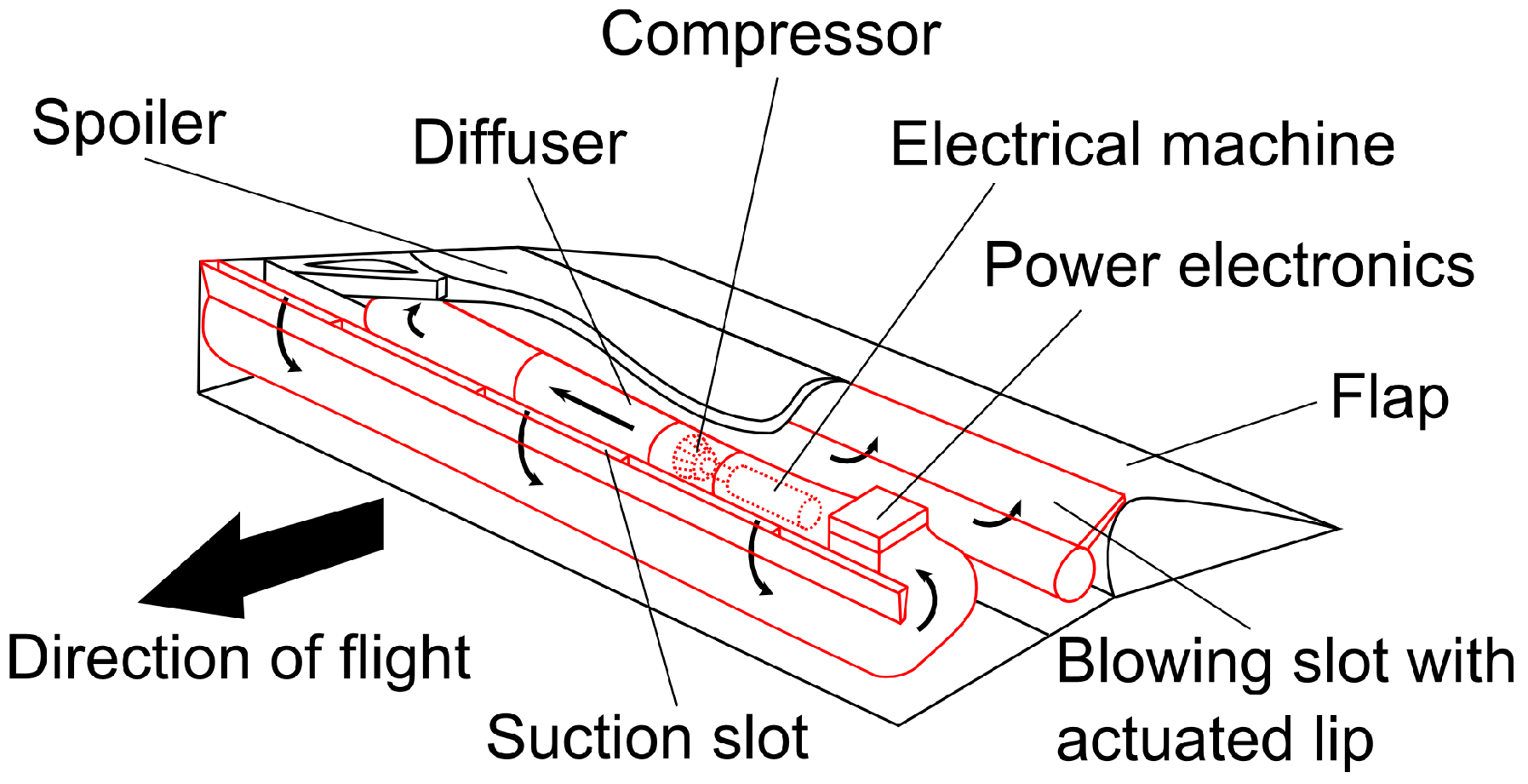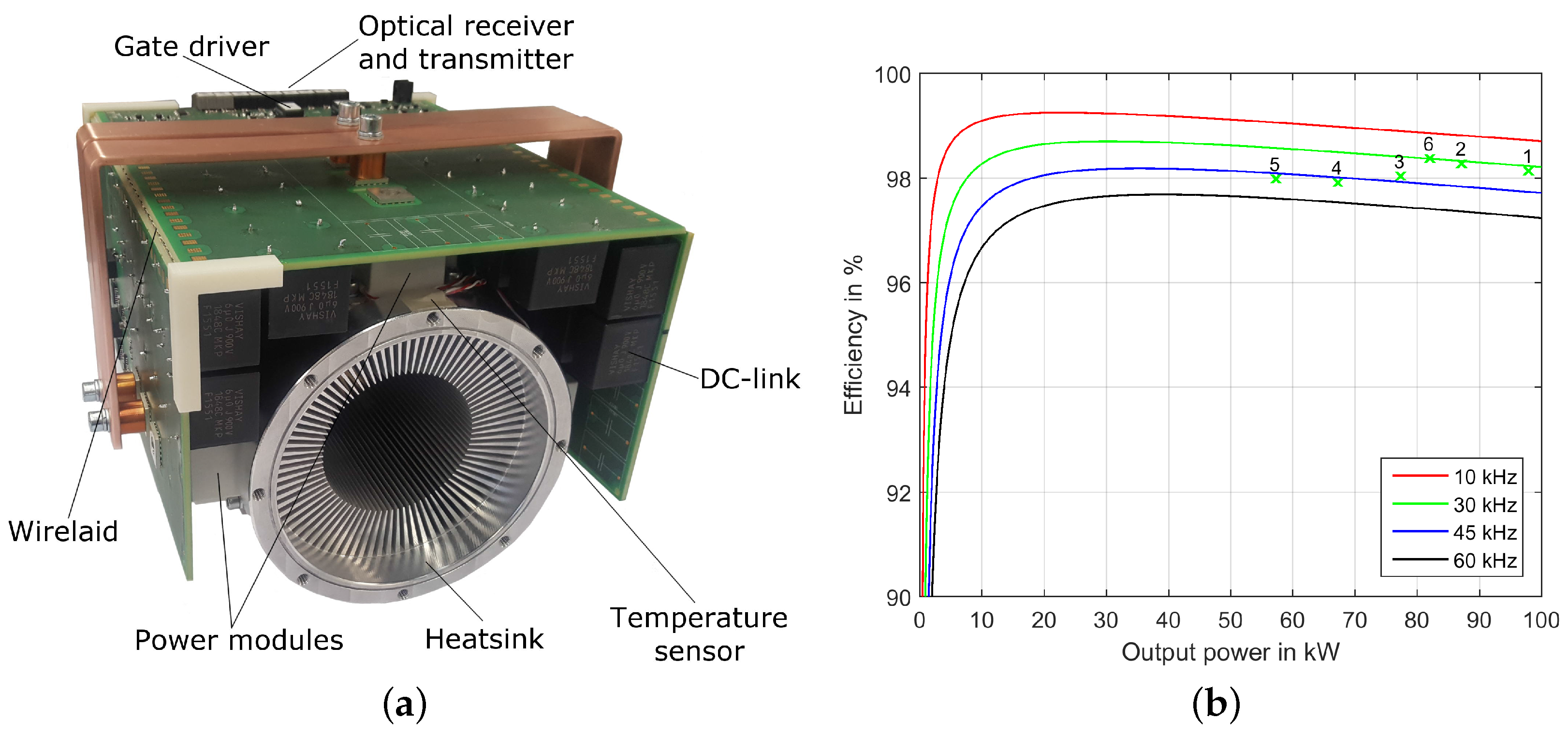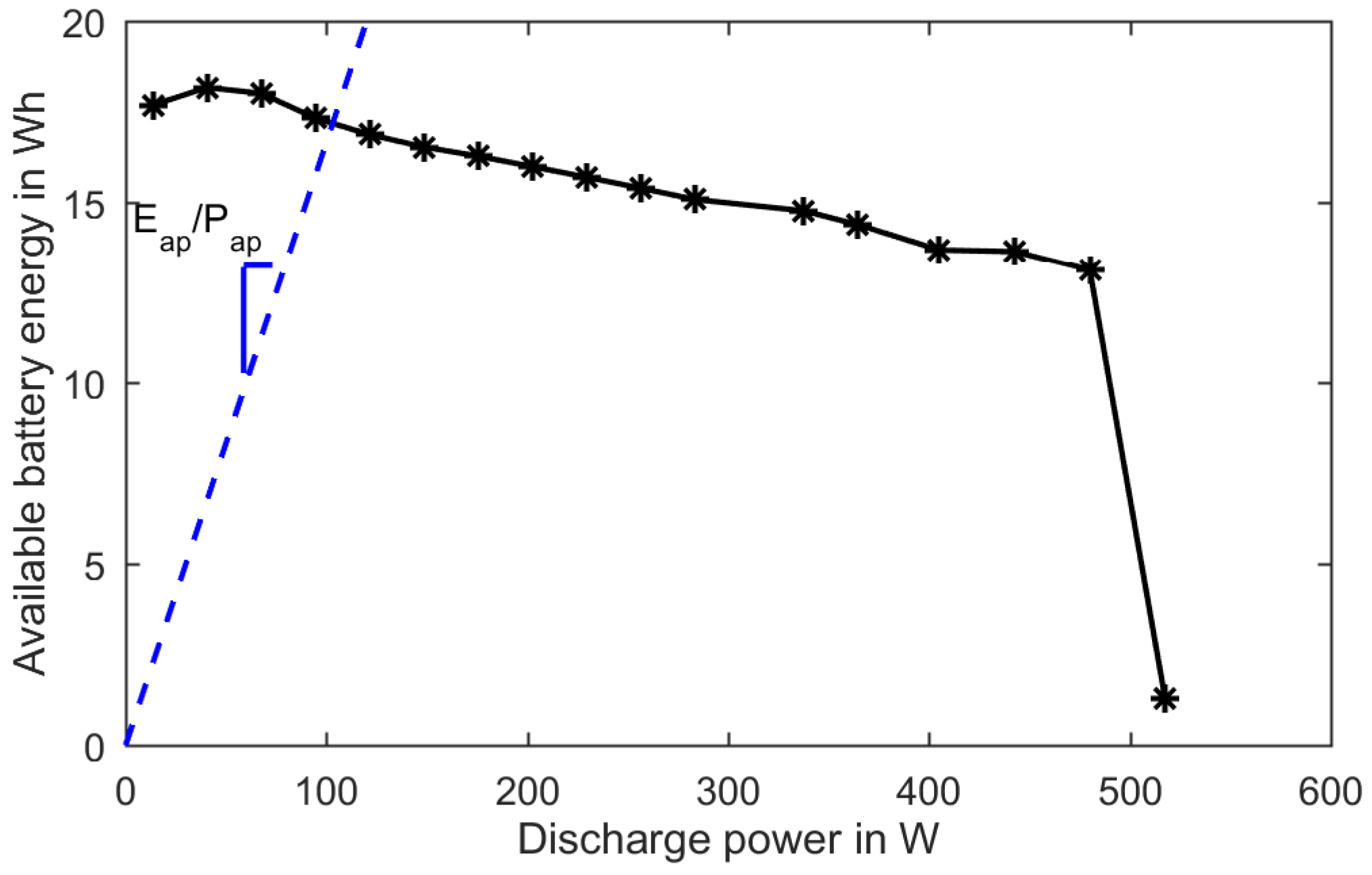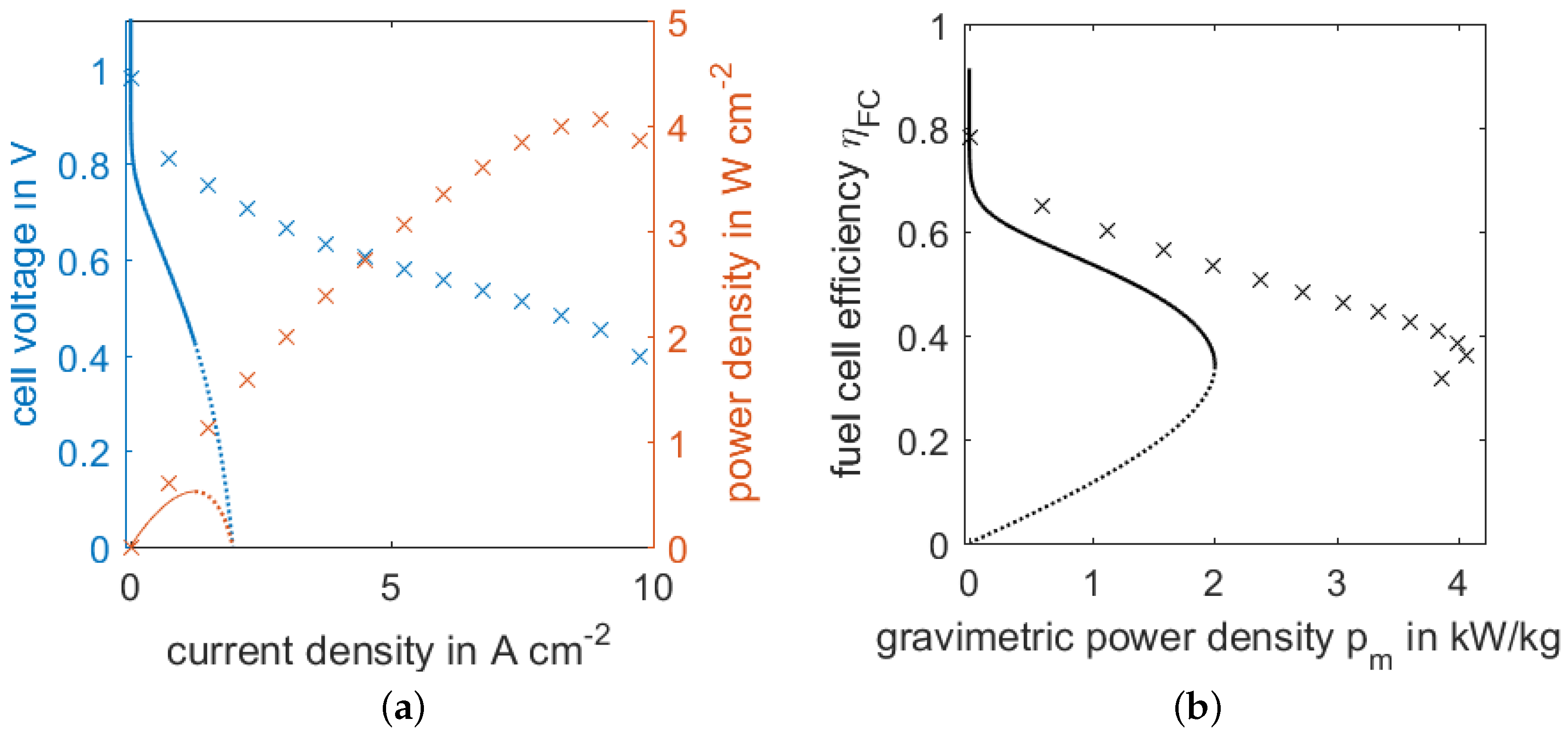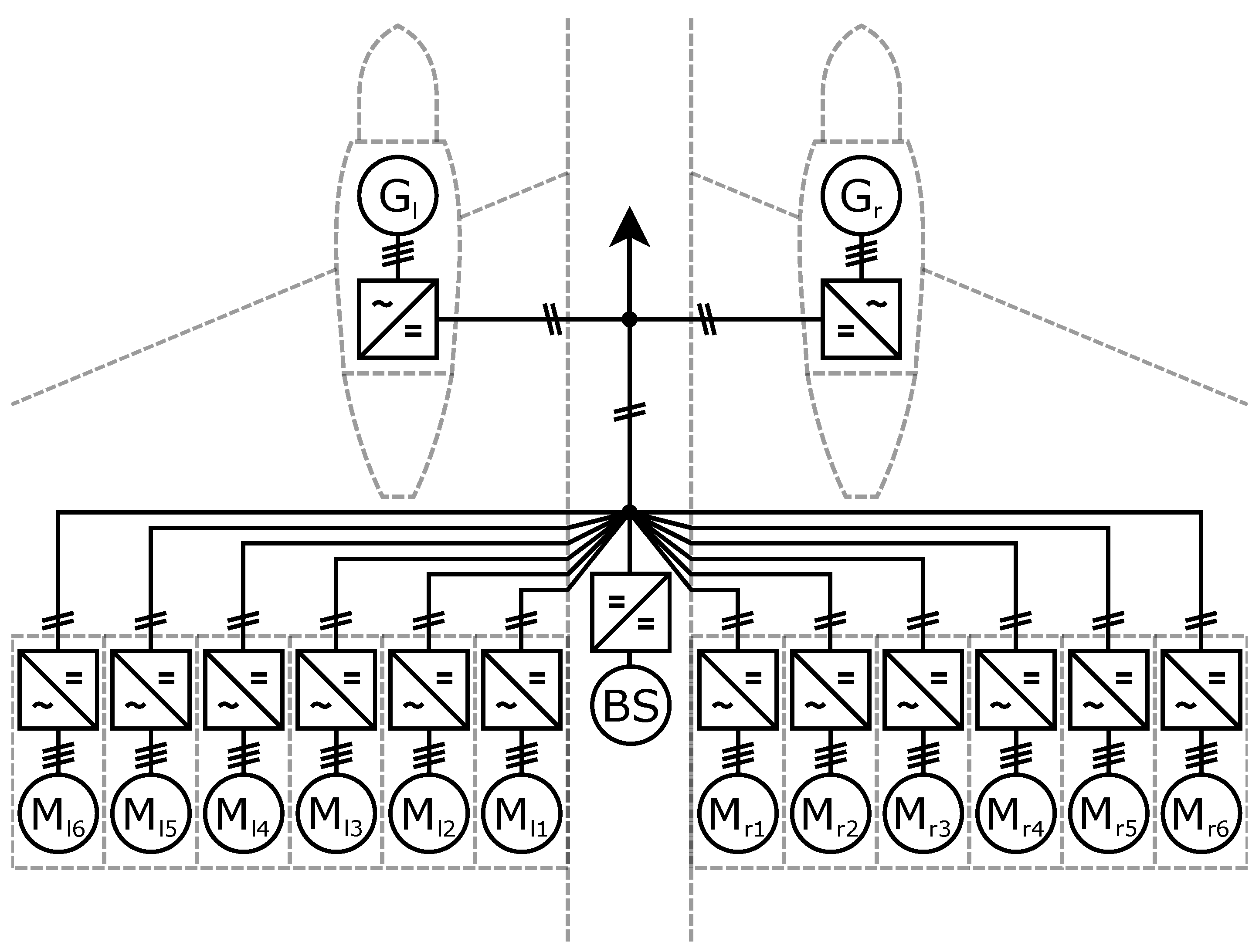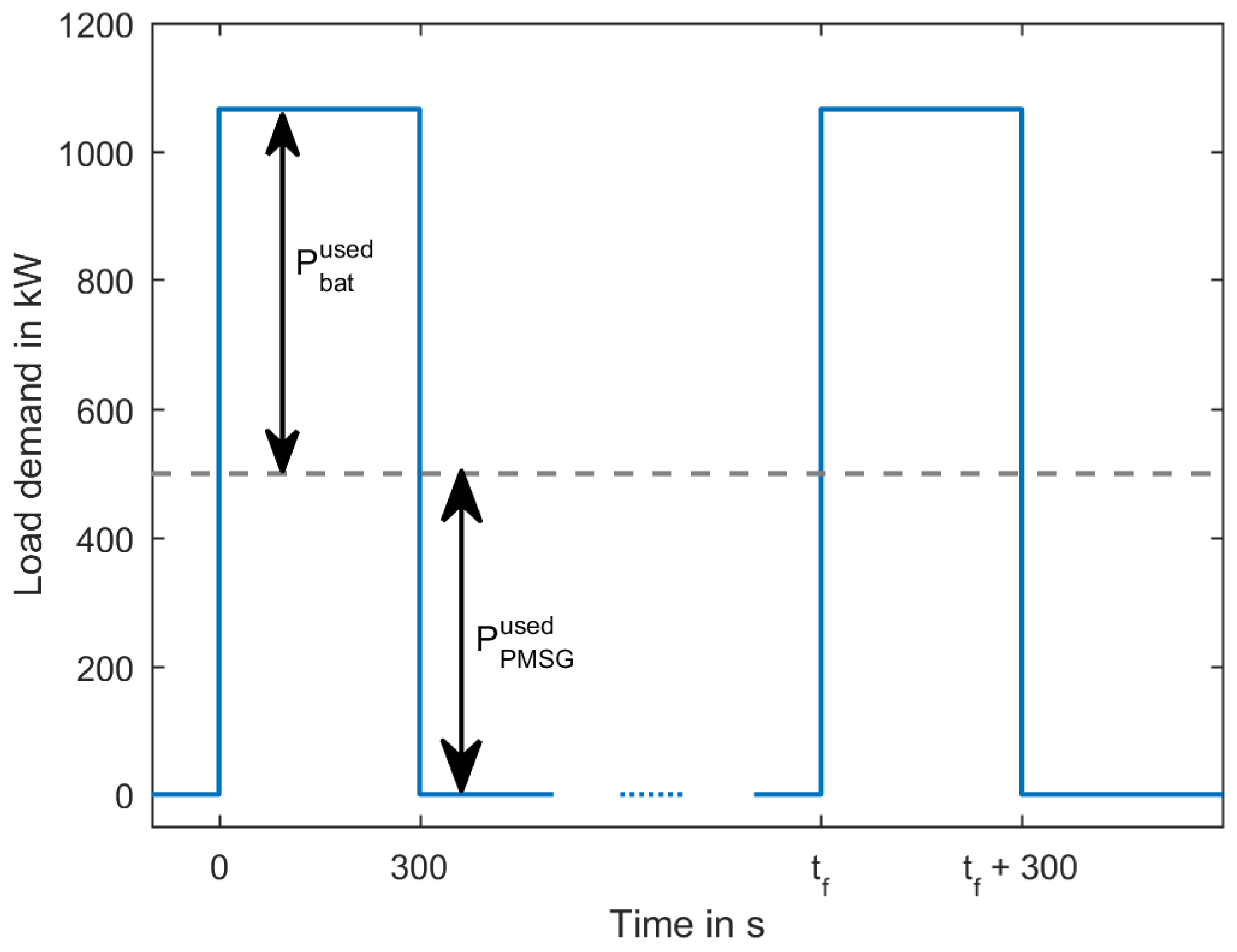For the first step of the concept evaluation of different power supplies, the components are designed in order to assess their key parameters. Taking into account the required power for the compressor-unit of the EPHLS and the efficiency of electrical machine and inverter, the DC power demand is calculated, which is the basis for the comparison.
2.2. Design of the Battery System
Different battery technologies have been applied for aircraft applications, e.g., Ni-Cd, lead-acid, and Li-ion (e.g., [
16]). Thereof, Li-ion batteries provide the highest gravimetric energy as well as power density of these technologies. For this reason, it is currently the most promising energy storage technology with regard to electrification of aircraft. In the present article, two different battery systems are analyzed. At first, a state-of-the-art Lithium-Polymer cell (Li-Po) is considered as an example for current Li-ion batteries. As a perspective for future systems, Lithium-Sulfur cells (Li-S) are taken into account. They are currently under development and are a promising option for future applications. In general, the energy capacity and the available power of a specific battery cannot be designed separately. Therefore, a good match between the ratio of maximal needed energy divided by the required maximal power and the corresponding performance of a specific battery technology is important.
The dimensioning of the current technology is performed based on measurements of a specific battery cell. It is a pouch cell, which is designed for automotive applications. The specifications are given in
Table 5. In order to determine the losses in high-power applications, constant power experiments were carried out. The methodology is described in detail in [
17].
Figure 6 shows the available discharged energy in dependency of the load power, holding all operating parameters, such as minimal voltage and maximum current (see
Table 5). In this diagram, the application requirements can be represented via a line with the slope of the needed energy divided by the required power (
in h). The most useful design point of the energy storage is its intersection with the measured data, resulting in the corresponding available energy of a single cell
at a certain power. The necessary number of cells is determined via
Therein,
is the necessary energy of the application and
are the losses due to peripheral components, such as pumps for the cooling system. Furthermore,
describes the time the application has to be served. The concrete architecture can be computed as follows: the number of cells in series connection
x results from the necessary nominal voltage of the DC–DC converter
and the maximal battery voltage
:
The number of parallel strings
y is
The resulting number of cells is .
In addition to the cells, the battery system consists of the battery management system and other electronic components, such as fuses, the housing and connectors of the single cells as well as a cooling/heating system to regulate the operating temperature. The thermal management is an important factor, since the ambient temperature varies extremely in dependency of the location of the aircraft and the weather. For the battery, an operating temperature between −20
and 55
C is necessary for the discharging process. However, the temperature influences the available energy of the battery. For the measurement shown, the ambient temperature is regulated to 20
C (results in
Figure 6). For the charging process, the temperature window is often even narrower.
The power demand for these peripheral components
is assumed to sum up to 8% of the application power [
18], which results in an efficiency of
. This includes the losses in the DC–DC converter discussed in
Section 2.1.2. In common automotive applications, the considered peripheral components increase the system weight by up to 43% of the cell weight [
19]. Therein, a cooling system with water as well as electronic components as connectors, etc. are included. It is well known that an aircraft application has higher safety requirements. For this reason, the peripheral components could account for a much larger weight portion. Tariq et al. [
16] estimated the weight of the peripheral systems by over 100% of the cell weight, for a small battery system for aircraft applications. This weight ratio is assumed to be smaller for large systems. For this reason, the value for automotive systems is used for the present analysis. The weight of the battery system can be calculated from the single cell accordingly:
In the same way, the volume of the battery system is computed as follows with the factor from [
20]:
For the future technology Li-S, no commercial product can be measured, and thus the characteristics gathered from literature have to be taken into account. These are given for complete battery systems including cooling, electronics and housing. The characteristics of a system for the year 2035 are summarized in
Table 6.
As described before, the needed energy capacity is either determined by the maximal power or by the energy that has to be supplied to the application:
Mass and volume are determined from the specific parameters given in
Table 6:
2.3. Design of the Fuel Cell System
The fuel cell design process employs a polymer electrolyte fuel cell model that is as simple as possible while still covering all relevant processes in physically meaningful, macroscopic parameters. Kulikovsky was able to obtain an approximate but accurate analytical solution [
24] to a well known model based on pioneering works of Perry, Newman and Cairns [
25] as well as Eikerling and Kornyshev [
26]. Using this analytical polarization curve has two main advantages: (1) the functional relationship between parameters and variables of interest is directly revealed; (2) the model has no computational limitations and can be included in larger model hierarchies, e.g., for aircraft design, aircraft fleet models or future aviation scenario modeling as well as the presented design process of the EPHLS.
In the model, the main losses of the fuel cell stem from the cathode catalyst layer. Ohmic losses are combined into one ohmic resistance,
, which covers membrane, electric, and contact resistances. The anode losses are considered to be negligible. The model is parameterized with typical parameters outlined [
24] to simulate the current state-of-the-art fuel cell technology. For the gravimetric power density, the value of
= 2 kW/kg achieved by current commercial Toyota Mirai fuel cell (FC) stacks is used [
27]. In order to estimate the future technology, experimental polarization curves of the currently best-performing fuel cells on the lab-scale are used [
28], achieving approximately
= 4 kW/kg. Similar to the battery section, it is assumed that this technology might be available in 2035. The resulting characteristic curves used for the design process are shown in
Figure 7. For a detailed discussion and derivation of these design curves, the reader is referred to [
29]. The fuel cell is sized so that its maximum power equals the maximum required power, which includes converter and cable efficiencies and a safety factor of 50%. This safety factor puts the normal operating point of the fuel cell at 2/3 of the maximum power.
As outlined in [
29], the fuel cell model is combined with a simplified compressor model and a detailed model for liquid hydrogen tanks. The mass of the hydrogen tank,
, is optimized for aviation application; model equations and a detailed discussion can be found in [
30]. The compressor is designed for an operation at cruising altitude (10,000 m) and for temperature-controlled operation, i.e., to compress the air until it reaches operating temperature of the fuel cell, 80
C. This has the advantage that no heat exchanger is necessary for air-conditioning, but has the disadvantage of flexible input pressure. However, under aviation conditions, pressures suitable for fuel cell operation are reached [
29]. The electric power required for this compressor is added to the required power, which in turn increases the size of the fuel cell. In this iterative way, the sizes of fuel cell and compressor are calculated. The compressor mass is calculated according to [
7] as
where
is the mechanical power the compressor exerts to provide the fuel cell with the required air mass flow with a stoichiometry of
and an isentropic efficiency of 0.8.
The mass of the fuel cell is
where
is the electric power required by the compressor. The mass of hydrogen can be calculated according to
where
MJ/kg is the energy density of hydrogen and
is the efficiency of the fuel cell at the working point according to
Figure 7.

